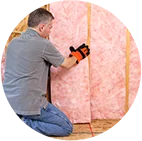Most people know what insulation is, at least on a very basic level. Do you know how insulation works, though? Many homeowners don’t know the specifics, but knowing how insulation works can be helpful.
So, exactly how does insulation work? Let’s first start with what insulation is. Insulation is a material that stops the transfer of heat, and the materials vary. There is fiberglass, cellulose, radiant barrier, rigid board, and spray foam.
Learn more about the different types of insulation.
How Does Insulation Work?
Insulation makes your home more energy-efficient by stopping heat transfer (meaning your home will stay cooler in the summer and warmer in the winter). The insulation material used determines HOW it resists heat flow. Radiant barrier, for example, helps your home reflect (rather than absorb) heat from the sun, while other types of insulation absorb heat – kind of how a blanket traps your body heat and keeps you warm when you’re in bed.
How well a type of insulation works (stops the transfer of heat) is measured in R-value. The R-value is a term that refers to the insulation’s resistance to heat flow – the higher the value, the better the insulation is at stopping heat transfer and keeping your space more comfortable. This doesn’t mean you should necessarily just install the type of insulation with the highest R-value; it’s not that simple. Different types of insulation work better in different areas of your home, and other factors also influence which type you’ll install:
- Where you live
- How old your home is
- The type of HVAC system you have
- Your home’s framing
- The type of attic you have
- And more
Insulation should be installed in all areas of your home – the attic, any crawl spaces, and the exterior and interior walls (basically anywhere heat can leak into or escape out of your home!).
Professional insulation contractors will be able to assess your situation and tell you which type of insulation you need. If you’re in Southern California, OJ Insulation is the company to call!









